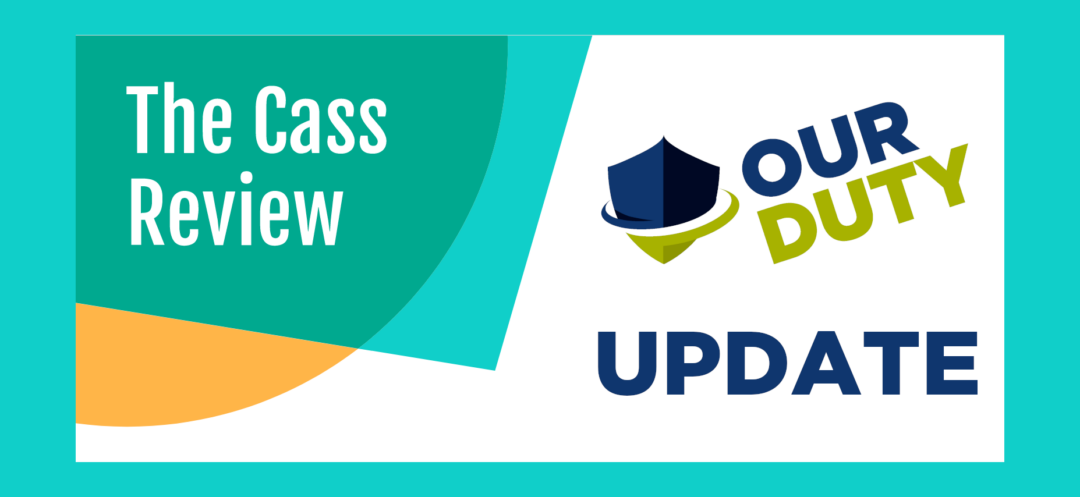Introduction
The Cass Review is being conducted as an independent review of gender identity services for children and young people, led by paediatrician Dr Hilary Cass. It has been running for two years and published an Interim Report in February 2022.
We have previously published responses to the Cass Review Interim Report, and a submission to NHS England for the consultation on the proposed interim Service Specification (which covers all the major issues). A high-level overview of that submission (2-minute read) is here.
This briefing is best read as an Addendum to those submissions.
Our Duty Leaflet makes the case that the Cass Review does not go far enough, and children and young people continue to suffer irreversible harm from the provision of cross-sex hormones:
“Medics have a duty to ‘first do no harm’ which can be qualified if benefits are in the best interests of their patients. Medical transition is clearly harmful with no evidence of net benefits.
Our Duty is sceptical of The Cass Review. A moratorium on opposite sex imitation treatments should have been a prelude to a genuine inquiry that is not inhibited by terms of reference that seek to “find consensus”. Moreover, the National Health Service is clearly captured by gender ideology, a genuine inquiry would, therefore, need to be truly independent of the NHS.”
Our overriding concern is that any new service must result in children and adolescents being safe from the risk of opposite sex imitation ‘medicine’.
This briefing consists of two sections – what the Cass review has missed so far, and what it will miss if it maintains its current trajectory.
What’s been missed:
Sense of urgency. Children and young people are being harmed by the NHS right now, there has been no call for a moratorium from The Cass Review. In addition, there are unregulated “private” providers of cross-sex hormones who dispense those at the whim of young adults.
Protecting adolescents. Most children end up in the adult clinics, this is because the average age of referral is 15.5 and the waiting list exceeds 2 years. We should be looking at an age range up to 25 (indeed the NHS long-term Mental Health plan for Children and Young People states an intention to raise the upper age for adolescent services to 25 by 2025).
Distinct cohorts. The cases of prepubescent boys remaining “persistent, consistent and insistent” in their claim to be the opposite sex are used to justify the current treatment protocols for that cohort being applied to the socially acquired transgender ideation of adolescents (predominantly girls). These cohorts need treating separately (and we need to investigate why 12% of prepubescent boys are being failed).
Evidence. Sometimes the best evidence is that of our eyes and ears, and established science. A boy cannot become a girl, or vice versa, we do not need a peer-reviewed paper to back this up.
Ideology. There is no recognition that the NHS needs fundamental cultural change (to rid itself of gender ideology) before it can be considered safe for young people with transgender ideation.
Accepted Practice. The duty to ‘first do no harm’ can be overridden if the proposed treatment is in the patient’s best interests. Underpinning this is the concept of accepted practice. There seems to be little questioning of whether opposite sex imitation should be accepted practice. Indeed, the GMC gave the impression (re: Helen Webberley) that opposite sex imitation is accepted practice. Why? Have not the WPATH SoC and The Dutch Protocol been sufficiently discredited?
Best Practice. Through our work with families, we know that the best chances of a child desisting from transgender ideation are when a firm and loving line is taken right from the start. We also know that the younger the child, the better chances of remission. A young person presenting with transgender ideation must receive immediate mental health support that assumes the notion of ‘transgenderism’ to be a maladaptive ideation which, if left unaddressed, will result in permanent and irreversible harm to the young person.
Where it seems to be headed:
‘True trans’. There is a risk that the Cass Review may perpetuate the myth of the “transgender child”.
Trans homogeneity. Young adults under 25 will remain at profound risk of harmful, ideological interventions. There’ll be no clear cohort delineation. Dangerous adult clinics will still be treating under 25s.
No specialist treatment. While The Cass Review recognises that the NHS lacks the capacity to deliver rapid mental health interventions, it is likely to eschew calling for the ideal services that young people need and will instead recommend a ‘pragmatic’ approach. This will mean no rapid intervention of the type that works.
Realm ignorance. There will be no recognition of transgender ideation and how best to treat it.
Cultural blindness. There will be no recognition that the NHS is ideologically captured by gender theory. Consequently, there will be no recommendations on cleaning up its organisations and training ecosystem. Institutional inertia and recycling of corrupt staff will result in a perpetuation of the status quo.
Following fashion. There seems to be an acceptance of the idea that this generation is more accepting of trans identities and that justifies providing the means for people to get them. The Cass Review seems unaware that the generational difference is entirely due to indoctrination in schools.
Conclusion
Many voices have been uncritical in their praise of The Cass Review. However, it does not seem headed towards providing a real overhaul the treatment of transgender ideation in the NHS and therefore, there remains a grave danger for the mental and physical health, and in some case, the life, of our children.

